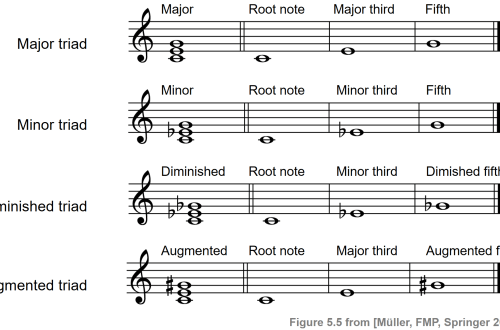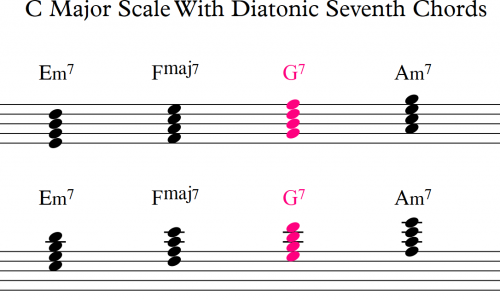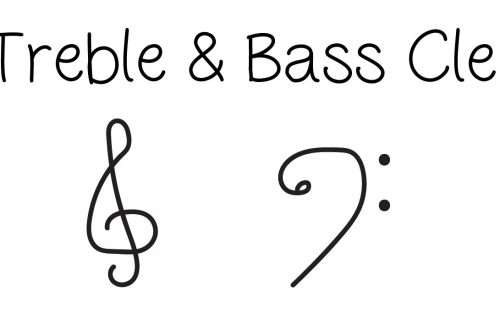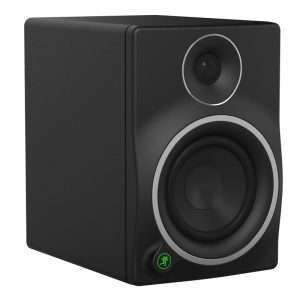
Musical staff with notes in pictures and a detailed description
Contents
You will learn what a musical staff is and why it is needed in music. I will show you how to use the arrangement of notes in the treble and bass clef. There will be many examples with pictures.
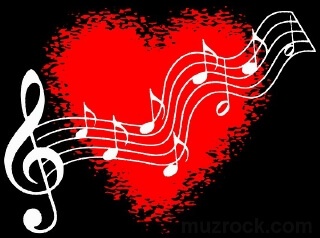
musical key
Traditionally, music is written using a system of five lines called a stave or staff. You see it in the picture below.
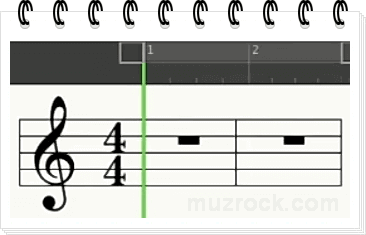
At the very beginning of the staff is placed the so-called musical key . It determines the pitch value of the notes recorded on the rulers and in the gaps between the rulers of the stave.
Basically, two types of keys are used:
- Violin
- Bass
Now we have a treble clef on the stave. And this is a musical staff. We see the lines and the gaps between them. We place notes on them.
The treble clef determines which note this or that line or interval will correspond to.
The bass clef looks like this. He dictates his own rules for placing notes.

The bass clef is used to record notes in low register musical instruments. A
treble is used to record a high-register instrument part.
In the last lesson about notes , we wrote about the middle “C” ( or before ). A note located in the middle of the piano range.
So, the treble clef is used for instruments whose range lies above this middle “C”. And the bass clef is used for instruments with a range below the middle “C”.
To use both keys, the so-called piano system is used . These are two staves joined by a curly brace. It’s called accolade .
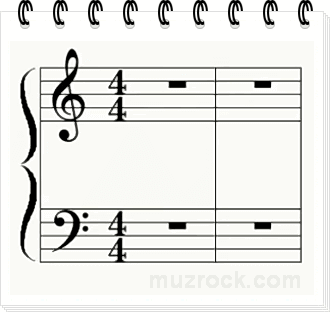
It is usually used for recording piano parts due to its wide sound range. One piano key is not enough.
In general, such a bracket ( accolade ) is used to join two keys. And it’s called the piano system.
But you only use one treble clef if you write notes for a high register instrument, and one bass clef if you write notes for a low register instrument.
stave
As already mentioned, the stave is used to record music in a system of five lines. Such a staff displays two musical aspects at once. It is temporary and high-rise.
Time is read horizontally. It can be expressed with notes and pauses. This thick line here is a pause.
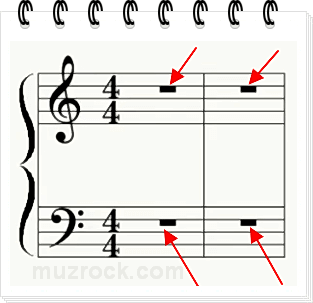
That is, time is read from left to right and is determined by the number of beats in a bar.
The pitch of the notes is read vertically. High notes are written on the rulers and intervals higher than low sounding ones.
That is, you read the score from left to right in order to understand the temporal aspect of the music. And from the bottom to the top to determine the height component.
The note can be located on any line or spaces between them. And if necessary, it is located even outside the stave on additional rulers .
The figure below is the middle note “Do”. Traditionally, it is also called the note “Up to the first octave” on the stave.
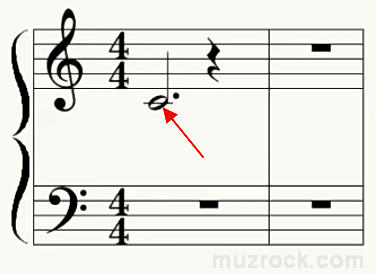
It is written between two staves on an additional line. This line expands the range of the stave.
Here is another example of an extension ruler. It expands the range of the staff in the direction of increasing the height.

Additional lines can expand the range both up and down. And also apply in both keys.
Notes of white keys
Let’s see how the notes of the white piano keys are written on the staff.
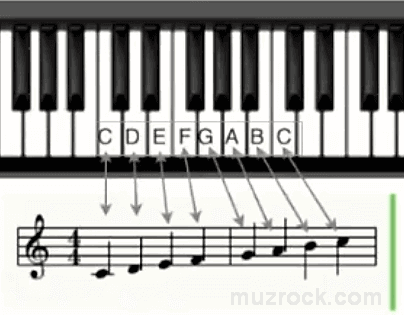
In this figure, we see that the first notes start with the first additional line. On it is the middle “C” ( note C to the first octave ). Notes without sharps and flats are called natural .
Therefore, we can say this.
Natural “Do” is followed by natural “Re”. Or after “C” comes “D”. This is if you are accustomed to the Western designation of notes on the stave.
The next note is “Mi” or “E”. Further “F” ( Fa ).
That is, they are all arranged as if on steps, successively filling in the lines and gaps.
After “Fa” come “Sol”, “La”, “Si” and then again “Do”.
Black Key Notes
Now let’s look at the stave with notes and sharps.

You can see from the picture that “To Natural” comes first. Further, “C sharp” is written on the same line, but with a sharp sign in front of the note. Here is a hash mark ( # ) in front of a note that indicates a sharp.
Then comes “D sharp” ( D# ) on the same line as “D”, but with a # sign. Next comes “Mi natural”, “F sharp”, “Sol Sharp”, “La sharp” and so on.
All these sharp notes represent the black keys of the piano.
You may have noticed that a different system of naming notes is used here. This is done so that you understand the correspondence between the syllabic and letter systems.
Let’s look at the flats (♭).

We start with “Up to the first octave.” Next comes “D flat” (D♭), which denotes a black note (a key on the keyboard ). Previously, we called it “C sharp” (C#).
Here is a small icon that looks like the letter “♭” means flat.
Next comes “E-flat” ( E♭ ). Then comes “F natural” because it doesn’t have a flat ( a black key on the keyboard ).
After that comes G-flat (G♭) and A-flat (A♭). Then “B flat” (B♭) and the note “C” (C) of the next octave.
This is how flat notes are written.
Music staff and bass clef
Let’s now see how the notes look on the stave in the bass clef.

Before us are notes of white keys. It looks like it was in the treble clef. Only here the notes begin with a different line.
This is because the bass clef determines the position of the notes.
But the stepwise principle is the same. Do natural, Re natural, Mi natural, Fa natural and so on.
That is, the same step-by-step principle of successive filling of rulers and gaps.
Sharps and flats on the stave
Now let’s see how sharps and flats look on the stave. Here is a photo below.

It goes “Do” (C), “Do#” (C#), “Re#” (D#) and “Mi natural” (E). Then “F#” (F#), “Salt #” (G#), “La#” (A#), “B natural”, “Do” (C).
These are all sharps in the bass clef.
Now let’s look at the flats of the bass staff.

We start with “Do” (C♭). Then “D flat” (D♭), which has a ♭ in front of it. This is followed by “E-flat” (E♭), “G-flat” (G♭) and “A-flat” (A♭). Then “B-flat” (B♭) and finally “Do” (C) of the first octave on an additional ruler.
How to learn notes on the stave
Now I will show you how you can learn the location of the notes on the stave. You are probably asking yourself, how do you know where to place this or that note?
To memorize the location of the notes on the stave, there is a saying in English. Now we will learn it.
After all, knowing the location of the notes on the stave is very important. Otherwise, you will not be able to read and write music.
For treble clef
Let’s start with the treble clef. Let’s deal with the lines.
To memorize the location of notes on the rulers, there is a saying.
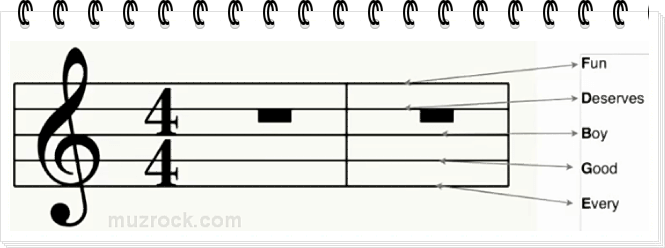
In Russian, literally – ” Every good boy deserves fun .”
The capital letters in this proverb represent the names of the notes. Thus, on the rulers of the treble clef, the notes are arranged in this order:
- E (mi)
- G (salt)
- B (si)
- D (re)
- F (fa)
It just needs to be remembered! It is very important to know the main points:
- Notes on the rulers and in the intervals in the treble clef
- Notes on the rulers and in the intervals in the bass clef
Now let’s learn the spans of the treble clef. It’s already easier here, since the English word “Face” comes ( that is, face ).
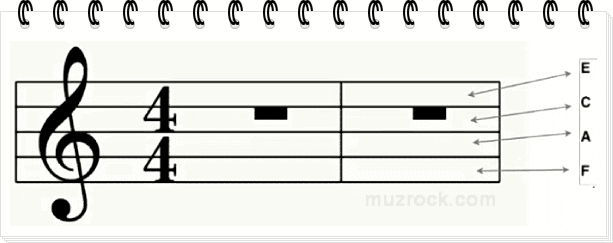
- F (fa)
- A (la)
- C (to)
- E (mi)
“F” goes on the first gap, “A” on the second, “C” on the third and “E” on the fourth.
Combining both sayings, we get:
- E (mi)
- F (fa)
- G (salt)
- A (la)
- B (si)
- C (to)
- D (re)
- E (mi)
- F (fa)
And for extra rulers, you just keep counting:
- G on the first additional gap
- A on the first extension line
- B for the next additional gap and so on
Same for the bottom:
- Note “D” goes below the first line
- Additional ruler with the note middle “C”
- Below it is the note “B” and so on.
For bass clef
Now remember the notes for the bass clef.
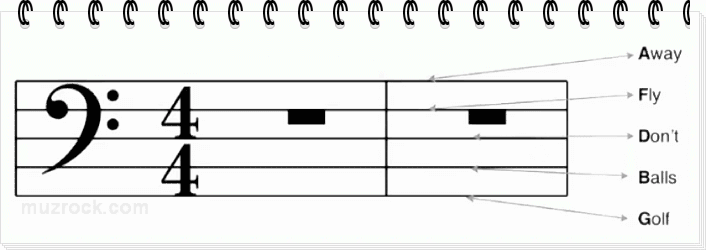
Here, the notes on the rulers are remembered with the help of a saying. Translated – ” Golf balls do not fly away .”
In Russian, you can use such a proverb – ” Salty blue river – porcelain lambda “.
Or:
- Salt
- Xi
- Re
- F
- la
These notes are on a third interval.
And in the intervals will be, as in the figure below. It translates as – ” All cows eat grass .”
In Russian, you can come up with your own saying. For example, ” The frog reached – the mine came down .”

Or
- la
- Before
- Mi
- Salt
Combining both sayings, we get:
- G (salt)
- A (la)
- B (si)
- C (to)
- D (re)
- E (mi)
- F (fa)
- G (salt)
That’s all!
Now you know how the notes of the bass and treble clef are located on the stave. To do this, we reviewed a lot of photos with examples and explanations.
For practice, I recommend that you work with the lower piano staff.
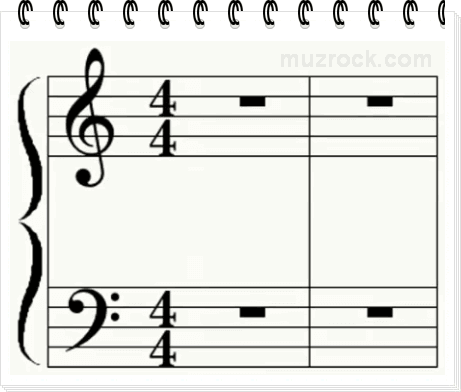
Try to arbitrarily choose some kind of ruler or gap. Determine which note it is in a particular key. Practice until you can more or less navigate the arrangement of notes on the stave.



